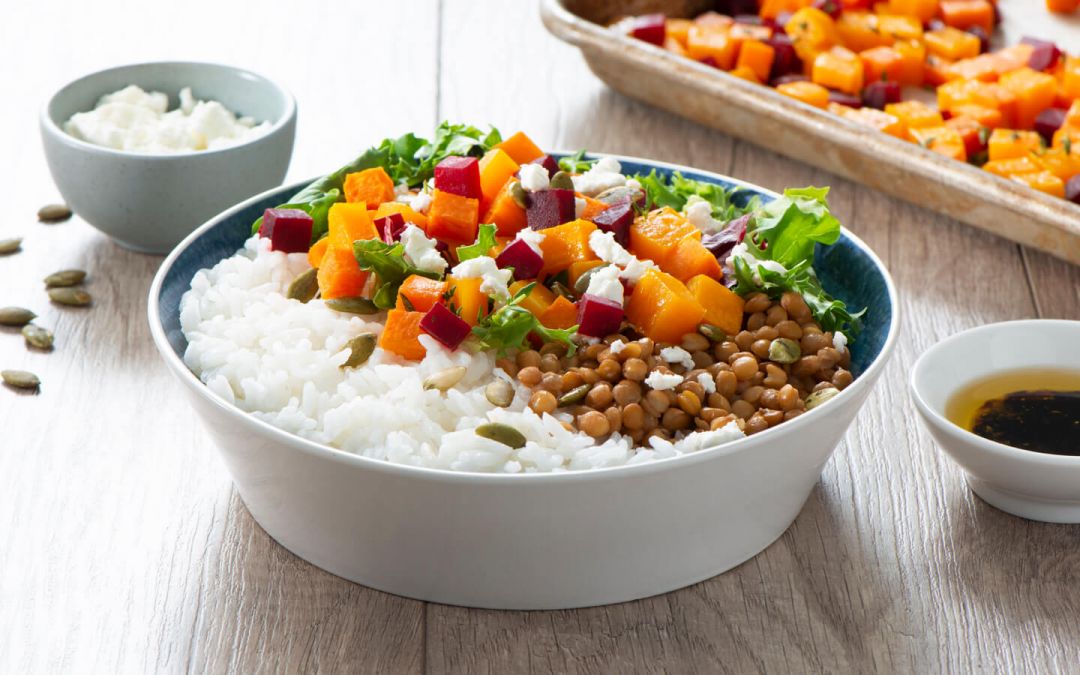Rice is a lot of things — delicious, nutritious, easy to cook, and incredibly popular across the globe! But is rice vegan? If you’ve ever asked yourself this question, you’re not alone. Whether or not you follow a plant-based diet, it’s important to know everything you can about the ingredients you cook with. Knowing what ingredients are made of, what they pair well with, and
being able to separate the myths from the facts will empower you in the kitchen and prep you to tackle any type of recipe.
Is Rice Vegan?
Simply put, rice is vegan. A plant-based food, rice is the seed of a semi-aquatic type of grass. To make the type of shelf-stable, edible rice we know, these seeds are harvested and separated from the straw. Traditionally, this was done by hand. Today, it is generally done by a machine called a combine harvester. The rice grains are then separated from their hulls, cleaned and dried. Some varieties of rice, such as basmati and white, are further processed to remove their bran and germ layers. Brown
rice has its bran layer and cereal germ intact, making it higher in fiber and more nutrient-dense than polished varieties.
10 Vegan Rice Dishes to Try
- Brown Rice Energy Balls: Stock up on vegan chocolate chips, and you’ll be nibbling on these tasty snacks in no time. No bake treats that blend Success® boil-in-bag brown rice with prunes, almond butter, flax seeds, honey and chocolate, these are nutrient-dense but taste like pure indulgence. Midmorning, in the dead of afternoon, as you rush between evening commitments, or as the last bite of the day, these vegan pick-me-ups never disappoint.
- Cuban Shrimp & Rice Tacos: A meal that’s ideal for eaters of every ilk, these shrimp, rice and bean tacos can be tailored to suit every diners’ needs. Fully cook the shrimp and set aside before preparing the seasoned rice and black beans. Then, invite everyone to dress their taco their way! With bites of citrus- scented rice, seasoned black beans, fresh cilantro and creamy avocado, plant-based eaters won’t miss a thing.
- Quinoa Green Bean Casserole: Take everyone’s favorite side dish and move it to the center of the table! With hearty Success® boil-in-bag quinoa, mushrooms, green beans, silky mushroom soup and a flurry of crispy fried onions, this hearty casserole makes a satisfying main course. Use a vegan brand of soup and omit the Parmesan cheese if cooking for vegans.
- Vegan Meatloaf with Brown Rice and BBQ Sauce: If you think plant-based dishes will leave you hungry, this barbecue “meatloaf” is sure to set you straight. Plump with lentils and oats, walnuts, veggies and Success® boil-in-bag brown rice,
this rib-sticking meal always satisfies. - Vegetarian Rice and Pho Dinner Bowl: More solid than soupy, this take on Vietnamese pho is flavored with ginger and star anise, cinnamon, fresh herbs and more. Cook with vegan sauces — soy, hoisin and sriracha — when avoiding animal products is top of mind.
- Vegan Dirty Rice: Just because it’s vegan doesn’t mean it can’t be dirty! Turn a plate of Success® boil-in-bag brown rice into a deeply-flavored dish that’s earthy and peppery with a hint of smoke thanks to a generous dash of Cajun seasoning. Flecked with eggplant, celery and red pepper, this dish is a complete plant-based meal in one.
- Vegan Chili with Quinoa: Comforting and warm, a bowl of this vegan chili can turn any bad day around. Simple to prep, it comes together in just 35 minutes, thanks to quick-cooking quinoa, and a host of pantry staples. Set out a slew of toppings — like vegan cheese and sour cream, chopped herbs, hot sauce, red onion and tortilla chips — and let everyone get creative with their bowl.
- Vegan Enchiladas: Ooey, gooey good, this enchilada recipe has the feel of a weekend meal but the prep-time of a
weekday go-to. Surprise the family with a veg-packed dish that’s hearty, thanks to Success® boil-in-bag brown rice, delicious, thanks to a cozy combo of ingredients, and comforting, thanks to vegan cheese that emerges from the oven looking golden, molten and utterly irresistible. - No Bake Peanut Butter Quinoa Cookies: Rice is vegan so why not use it in a plant-based treat everyone will love! A cookie recipe you can make without even turning on the oven, these peanut-packed gems are full of oats, coconut
and Success® boil-in-bag tri-color quinoa. Just the thing to satisfy a vegan sweet tooth, these are also popular with carnivores, pescatarians, vegetarians, and more. - Creamy Coconut Tropical Quinoa: Set sail to the tropics with this lush breakfast bowl. Made from a base of coconutty quinoa, it’s sweetened with brown sugar, seasoned with cinnamon and vanilla, then topped with ripe fruit, lime zest and shredded coconut. Eat it in the morning, as an afternoon snack or after dinner — we won’t judge!
Rice IS Vegan!
Now that you know that rice is vegan, you can play with it to your heart’s content! A plant- based ingredient that you can jazz up with herbs and spices, sauces, nut butters, vegan proteins, legumes, vegetables and a host of other ingredients, rice is a pantry godsend that makes meatless meal-planning a breeze. With rice as a base, you can adjust any recipe — even those that include animal-based ingredients — and eat meals that are delicious, nutritious, and good for the planet, every single day of the year.

